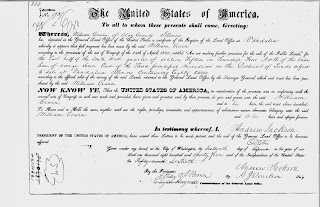I’ve been highlighting ancestors that made highlighting easy
because somebody wrote about them in a book or there was some quirk in their
history that brought up questions. But
we have more relatives that just quietly lived their lives, with the daily
struggles to make a living, and the sorrows and joys we all share in the making
of a life, but which aren’t recorded in government forms or written about in
the newspaper. Samuel Myers Hartman was
one of those men …at least until he turned 79.
As Samuel Myers Hartman’s father was named Samuel, and he
named one of his sons Samuel Thomas, I will refer to Samuel Myers Hartman as
Samuel M.
Samuel M. was born a farmer’s son, and he became a farmer as
well. His father, Samuel, owned property worth $1001 in 1850 in the Canaan
Township of Wayne County OH. At that point they had 8 children, ranging from 19
to just born, and young Samuel M. was 6 years old. (1850 Census) By the time
Samuel M. was 16, his father had become a very successful farmer, owning
$18,200 worth of real property and $1573 of personal property. (1860 Census.) [For perspective, a 4 room apartment rented
for $4.45 cents a month in 1860; land sold for $3-$5 an acre; a laborer’s wage
without board was 90 cents a day; eggs were 20 cents a dozen. (http://www.choosingvoluntarysimplicity.com/what-did-things-cost-in-1860/)]
When he was 23, Samuel Myers Hartman married Julia Ann
Zimmerman, daughter of the previously discussed Mennonite soldier. (1900 census)
Over the course of their marriage they had 6 sons and 5 daughters (Charlie,
Ettie, Dellie, Fanny, Zoe, Jesse, Samuel Thomas, Wellie, Odo, Henry, and Cleo).
In 1875, when he was 31, he moved his family from Wayne County, Ohio and moved
to Allen township in Hancock County, Ohio [or, for those of us not used to
thinking in counties, from somewhere near Wooster OH to somewhere near Findlay
OH], and again took up farming. By the time Samuel M. was head of his own
household, the census forms had stopped asking for a valuation of property owned
so I can’t give a comparison to his father, but we do know that he supported
eleven kids, and had enough money later in life to be able to retire and move
into a home in Findlay and to own an automobile. His wife Julia Ann died in
1913 at the age of 68, leaving him a widower.
Samuel M. married again four years later, in 1917, to Hattie Tarr
Breasler. He was 73. [Obituary, The Findlay Morning Republican, Wednesday, June
20, 1928, p. 12. 1880, 1900, 1910 & 1920 Census]
In the spring of 1923, when he was 79, Samuel M. got in an
automobile accident in Findlay at the corner of First and Main streets. The
driver of the other car sued him for $4500 in damages, and Samuel M.
cross-claimed for $1200. It must have been one a heckuva accident! [Again, for
perspective, the average car cost $393; the average house cost $8,142; the
average wage was $1066; 2.5 lbs of coffee was $1.] On the eve of trial the
parties came to an undisclosed settlement on January 18 , 1924. [Note to self: Remember to write the court for a copy of pleadings and settlement agreement.](http://thecostofliving.com/index.php?id=147
; The Findlay Morning Republican: Monday, November 5, 1923, p.14; Thursday, January 17, 1924, p. 14; Friday,
January 18, 1924, p. 3; and Wednesday, June 20, 1928, p. 12.)
Samuel M. Hartman, died at one o’clock on June 19, 1928 at his home, at 318 First street, Findlay, Ohio, of cerebral hemorrhages, following a serious illness of two weeks. He was 83 years old.The
funeral was held at two o’clock June 21, 1928 from the residence on First Street,
with Rev. W. I. Alexander, former pastor of the Pine Avenue Presbyterian
Church, where Samuel M. had been a member for the past eleven years,
officiating. He was buried in the Van Buren cemetery. He was survived by
nine of his children: are Charles Hartman, LaGrange, IL; Mrs. Etta Archer,
Bartlesville, OK.; Mrs. Zoe Rader, Alvada, OH; Mrs. Fanny Erwin and H.B.
Hartman, both of Findlay, OH; J.E. Hartman, Bluffton, OH; W.J. Hartman, O. L.
Hartman, and Mrs. Cleo Duffield, all of Van Buren, OH. [Obituary, The
Findlay Morning Republican, Wednesday, June 20, 1928, p. 12.]








